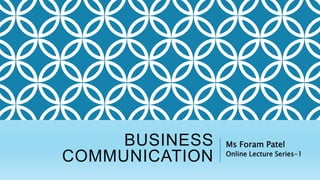
Communication LSRW
- 1. BUSINESS COMMUNICATION Ms Foram Patel Online Lecture Series-1
- 3. TYPES OF COMMUNICATION - L I S T E N I N G - S P E A K I N G - R E A D I N G - W R I T I N G
- 5. METHODS OF COMMUNICATION - Written Communication - Oral Communication - Verbal Communication - Non-verbal Communication - Visual Communication - Audio-visual Communication - Computer-based Communication
- 6. WRITTEN COMMUNICATION Written communication includes • letters • circulars • memos • telegrams • reports • minutes • forms and • questionnaires • manuals etc.
- 7. MERITS: 1. It is accurate and precise: Since written communication is open to verification, and its authenticity can easily be challenged the communicator has to be accurate and factual. It also demands precision. 2. It can be repeatedly referred to: The receiver of the written communication can go over the message again and again. He can read and re read till ho understands the message. Besides, there is less danger of losing message from it.
- 8. MERITS: 3. It is a permanent record: It becomes a permanent record of an organization and can prove very useful for the suture use. 4. It is a legal document: written communication is acceptable as a legal document. That’s why some executives insist that even some message is transmitted orally; it has to be confirmed later in writing.
- 9. MERITS: 5. it facilitates the assignation of responsibility: if communications are preserved in writing, it is easier to assign responsibilities. In case a mistake is committed in result, it becomes difficult to ascertain whether the mistake was of communicator or receiver. 6. It has a wide access: communication media having becomes very fast, written communication enjoys wide
- 10. LIMITATIONS 1. It is time-consuming: a letter may take several days to reach to its destination. However with increasing electronic media, it has become possible now to reach early. E. g. Fax etc.
- 11. LIMITATIONS 2. It is costly: writing letters is a costly process not in the terms of money but it consumes time of people involved in.
- 12. LIMITATIONS 3. Quick clarification is not possible: In case of receiver having certain doubts, or questions about the message, he can not seek immediate clarification. He has to write back and wait for a reply.
- 14. ORAL COMMUNICATION: Oral communication includes - Face to face Communication - Conversation over telephone - Radio broadcast - Interviews - Group discussion - Conferences - Seminars - Announcements over the public address system - Speeches - Meetings
- 16. MERITS: 1. Oral communication saves time: in a number of cases where action is required to be taken immediately, it is best to transmit a message orally. 2. Speech is more powerful means of persuasion and control: Therefore executives often prefer to transmit messages orally. 3. With the help of variations in the tone, pitch and intensity of voice, the speaker can convey shades of meaning which he would not be able to do through written communication. 4. The speaker can get immediate feedback: on whether it is creating a favorable impression on the receiver, has clearly understood the meaning, or not.
- 17. MERITS: 5. Although the employees feel more secure when in possession of writing messages, they find the oral messages more reliable, for they get an opportunity for feedback and clarification. 6. The informal channel, through which oral communication is carried out, helps to promote friendly relations between the parties communicating with each other. 7. Oral communication is extremely useful while communicating with groups at assemblies, meetings etc.
- 19. LIMITATIONS 1. Oral communication is not possible if the communicator and the receiver are far removed from each other. 2. Lengthy messages are not suitable for oral transmission for there are chances of something important being missed. 3. Oral messages can not be retained for a longer time. 4. Oral messages do not have any legal validity unless they are recorded and a part of permanent record.
- 20. FACE TO FACE COMMUNICATION Face to face communication may sound similar to oral communication, but in certain situations it may differ. E. g. telephonic conversation is an oral communication but not face- to-face.
- 21. MERITS 1. Facial expressions and gestures help to communicate better As already mentioned, oral communication is better than written communication, the message is reinforced with the help of tone, pitch and intensity of the speaker’s voice. The message being communicated also gets the assistance of facial expressions and gestures. 2. Particularly suitable for discussion Face-to-face communication is particularly suitable for discussion, for there is immediate feedback from the total personality of the
- 22. LIMITATIONS 1.Difficult to practice in large size organizations. Particularly modern organizations where various units are situated at different places. 2.Not effective in large gathering. It is very difficult to get message across to large gatherings, even though the speaker is addressing them face-to-face. 3.Ineffective if the listener is not attentive. A limitation which the face-to-face communication shares with oral
- 23. Thank you…!
